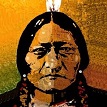I. George Armstrong Custer
A. Definitive scholarship
1. Stephen Ambrose: Crazy Horse and Custer (1975)
2. Evan Connell: Son of the Morning Star (1984)
3. Robert Utley: Cavalier in Buckskin (1988)
4. James Donovan: A Terrible Glory (2008)
5. Nathaniel Philbrick: The Last Stand (2011)
B. Unjustly treated by history
1. Leading Indian killer → NO!
2. Devoted Indian hater → NO!
3. Victim of skewed political correctness → YES!
C. Personal traits / qualities
1. Stunning but not overly handsome
• just under 6' tall
• yellow shoulder-length hair
• vivid blue eyes
2. Brave, aloof, ego-centric, passionate, energetic
• formula for dangerous military leader
• affectionate toward wife (Libbie) & pets
• crude practical joker; did not hold grudges
D. Background
1. Great-grandson of Hessian officer (Küster)
2. West Point graduate (34 of 34 w/ demerits)
3. Fought at First Bull Run as second lieutenant
• promoted to brigadier general at age 23
• constant battlefield gallantry ("Custer's luck")
• respected by soldiers (both North & South)
• designed own flashy uniform
E. Immediate post-Civil War record
1. Rank reduced then promoted to lieutenant colonel
2. Assigned to Fort Riley, Kans.
• suspension & court-martial for AWOL (1867)
• retaliatory attack at Washita River, Okla. (1868)
✓ murder of women & children?
✓ abandonment of Maj. Elliott & men?
3. Custer's 7th = high desertion & top horsemanship
F. Transferred to Fort Abe Lincoln, Dakota Terr. (1873)
1. Black Hills Expedition (1874)
• solve question of gold
• locate site for additional fort
2. Critical of Pres. Grant's Indian policies (1876)
II. Plains Indian Wars
A. Tribes of the Great Plains
1. Sioux → Minnesota & Dakotas
2. Cheyenne → Colorado & Wyoming
3. Comanche → Oklahoma & northern Texas
4. Arapaho, Crow, Kiowa, others
B. Common elements among Plains tribes
1. Horse provided mobility (hunting, warfare, travel)
2. Buffalo supplied all life's necessities (+ extras)
3. Tribes' unwillingness to unite hurt overall effort
4. Excellent cavalrymen & guerrilla fighters
C. Sioux
1. Not native to Dakotas
2. Offered esp. fierce opposition to white encroachment
3. Frontier melding of horse (Spain) & rifle (France)
III. Fort Laramie Treaty of 1868
A. Prior notable military engagements
1. Sioux Uprising aka Little Crow's War (Minn. 1862)
2. Chivington Massacre at Sand Creek (Colo. 1864)
3. Fetterman Massacre on Bozeman Trail (Wyo. 1866)
• + Wagon Box Fight, more = Red Cloud's War
• Ft. Phil Kearny = 1 of 3 protective forts
• only campaign defeat of U.S. Army by Indians
B. Est'd Great Sioux Reservation
1. West ½ of southern Dakota Terr.
2. From Missouri River & inc. Black Hills
C. Also stipulated "unceded Indian territory"
1. Between Black Hills & Bighorn Mtns
2. Powder River region (Bozeman Trail abandoned)
D. Created division among Sioux
1. Red Cloud & Spotted Tail → 15,000 on reservation
2. Sitting Bull & Crazy Horse → 3,000 hostiles (+ 400)
3. Many adjusted seasonally
|

& HISTORY

|
|
|
IV. Battle of the Little Bighorn (June 25, 1876)
A. Three-pronged approach
1. Gen. Terry west from Ft. Abe Lincoln, N. Dak.
2. Col. Gibbon east from Ft. Ellis, Mont.
3. Gen. Crook north from Ft. Fetterman, Wyo.
B. Custer sent by Terry ahead to Little Bighorn
1. Mission = prevent Indians' escape
2. Declined additional forces
3. Warned about early attack, but w/ wiggle room
C. Custer commences battle
1. Believed (incorrectly) detection by Indians
2. Divided already outnumbered command
• Maj. Reno → attack encampment from S (3 cos.)
• Capt. Benteen → sweep bluffs SE of village (3 cos.)
• Capt. McDougall → guard pack train (1 co.)
• Lt. Col. Custer → engage village from NE (5 cos.)
3. Vs. 2,000+++ Sioux & Cheyennes
• Sitting Bull = spiritual emissary
• Crazy Horse = warrior "chief"
• Gall, Rains In The Face, Two Moons, others
D. "Last Stand"
1. 7th = 250+ casualties
• Custer entirely obliterated (inc. 4 relatives)
• sole survivor = Comanche; Nathan Short (?)
2. Custer's death
• wounds: heart, left temple, right forearm
• naked w/o heavy mutilation (finger & ears)
• possible reason body left intact
• killer = White Bull (Sioux) or Black Bear (S. Chey.) or ?
3. Indians = 50-100+ casualties (difficult to guess)
E. Judgment
1. Responsible critique
• must evaluate w/ Custer's knowledge bank
• must offer acceptable alternative actions
2. Apparent blatant tactical military errors
3. Custer's past successes in similar situations
4. Glory bound w/ possible political aspirations
5. Performance of subordinate officers
• Reno's incompetence
• Benteen's puzzling delay
6. Battle credit owed to enemy chiefs & warriors
F. Aftermath
1. Indians' last stand, too
• alienated many white sympathizers
• gov't bent on avenging Custer's defeat
2. Crazy Horse, Sitting Bull, Reno, Benteen, Libbie
3. Paintings = 1,000+
• C. Adams & O. Becker: Custer's Last Fight (1895)
• Edgar Sam Paxson: Custer's Last Stand (1899)
• Eric von Schmidt: Here Fell Custer (1976)
4. Custers buried at West Point (NY) Cemetery
5. Reno (ironically) only 7th officer buried at Little Bighorn
|




